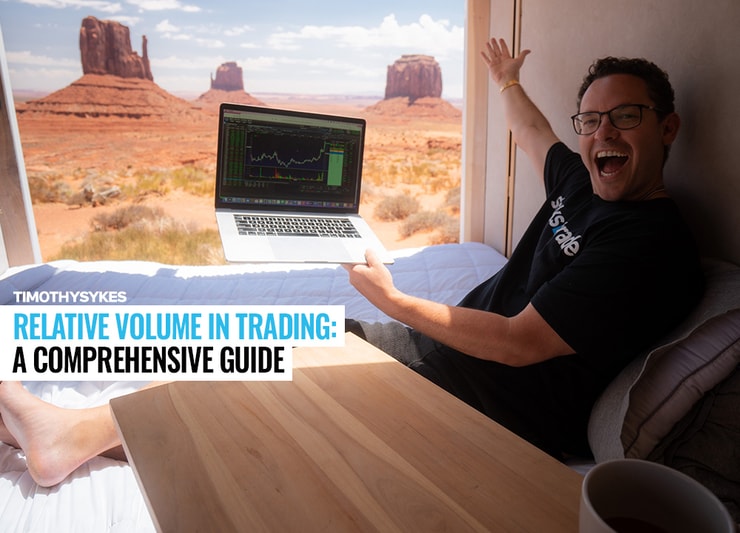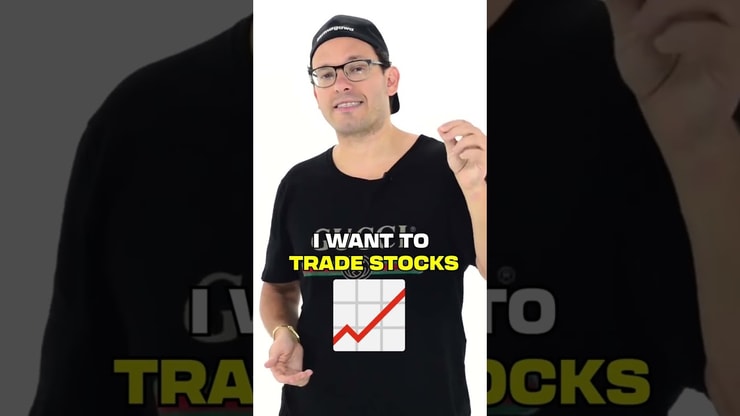Relative volume in trading is among the most important indicators for short-term price moves. In my nearly two decades of teaching, I’ve talked about unusual volume as the single biggest indicator traders should be looking at…
RVOL puts it all into one indicator.
Volume is the number of shares traded in a day. High volume indicates a lot of interest in a stock, and that can lead to significant price movements. But here’s the kicker: not all volume is created equal. That’s where relative volume (RVOL) comes in.
RVOL is a ratio that compares the current trading volume of a stock to its average trading volume. It’s like volume on steroids. It gives you a sense of whether a stock is seeing more or less trading activity than usual. In the world of penny stocks, where volatility and liquidity are the name of the game, that’s valuable information.
In this article, we’re going to break down how you can use RVOL as a tool in your trading strategies, how it can affect your trading results, and why it’s a key indicator for day traders. We’ll also discuss how it can help you identify breakout moves, manage risk, and make informed decisions about when to enter and exit trades.
Let’s get into it!
Table of Contents
- 1 What Is Relative Volume in Trading? An Initial Look
- 2 A Comprehensive Understanding of Volume in Trading
- 3 The Importance of Relative Volume in Trading Strategies
- 4 Analyzing Relative Volume for Informed Trading Decisions
- 5 Unpacking the Benefits of Using a Relative Volume Indicator
- 6 Mastering the Use of a Relative Volume Indicator in Trading
- 7 Key Takeaways on the Role of the Relative Volume Indicator in Trading
What Is Relative Volume in Trading? An Initial Look

2025 Millionaire Media, LLCRelative Volume (RVOL) is a trading indicator that compares the current trading volume of a stock to its average trading volume. It’s a ratio that provides a snapshot of the interest in a stock compared to its typical level of interest.
RVOL is a crucial tool for traders — we care about a stock trading more than average, not a universal level of volume. That usually leads to price spikes, as the price changes to reflect increased demand.
It’s an indicator that every day trader should be familiar with. By understanding the RVOL, traders can gain insights into the stock’s liquidity, the number of shares being traded, and the potential for future price action.
These metrics are more important in the world of day trading than any other part of trading. If this is news to you, check out this comprehensive guide on Day Trading. It’s crucial to have a well-rounded understanding of different strategies to make the most informed trading decisions.
A Comprehensive Understanding of Volume in Trading
Volume in trading refers to the number of shares or contracts traded in an asset during a given period. It is one of the simplest yet most important indicators used by traders and analysts.
Pay attention to volume! Utilize this: https://t.co/gNL09zPAPX learn to find high volume stocks and improve your strategy $FB $TWTR
— Timothy Sykes (@timothysykes) March 2, 2020
Volume provides clues about the intensity of trading activity and the strength of price moves.
When a stock’s volume is higher than usual, it can be indicative of future price moves. That’s why volume is one of the indicators I watch the most…
Why Is Volume Integral to Trading?
Volume is integral to trading as it provides insights into the strength and significance of price moves. For instance, a price rise on high volume indicates strong buying interest and is a bullish signal, while a price rise on low volume might be less significant as it shows a lack of buying interest. See also: pumps.
Similarly, a price drop on high volume is a bearish signal indicating strong selling interest, while a price drop on low volume might be less significant.
Volume affects more than just the stock chart. Volume gives a catalyst its power. And without a sufficient amount of volume, brokers and markets wouldn’t have the ability to create the liquidity I use to trade!
While analyzing volume and activity levels is essential in relative volume trading, it’s also beneficial to understand how different trading strategies can influence these factors. For instance, a reversal trading strategy can sometimes lead to significant changes in volume and activity levels.
To learn more about how this strategy works and how it can impact volume and activity levels, take a look at this detailed article on Reversal Trading Strategy. The more strategies you’re familiar with, the better equipped you’ll be to interpret volume and activity levels and make effective trading decisions.
More Breaking News
- Is BitMine Poised for a Strategic Breakthrough?
- Opendoor Technologies Soars Amid Leadership Shift
- From Investment to Freefall: What Happened to NAKA?
- SPRB’s Wild Ride: Understanding Today’s Market Move
The Importance of Relative Volume in Trading Strategies

2025 Millionaire Media, LLCRelative Volume (RVOL) takes the concept of volume a step further by comparing the current volume of a stock to its averages. This comparison provides a more nuanced view of trading activity and can be a valuable part of a trader’s strategy.
My approach is to eye the chart instead of using complicated studies on volume ratio and other forms of analysis. In either case the result is the same — every trader should have a basis in RVOL if they want to achieve profitability and grow their account!
How Can Relative Volume Aid Traders?
A higher RVOL indicates that a stock is being traded more than usual. This could be due to a variety of factors, such as a company announcement or market news, any of which could signal a significant price move.
Conversely, a lower RVOL suggests that trading activity is lower than average, indicating a lack of interest in the stock.
By understanding the RVOL, traders can better interpret the market’s movements and make more informed decisions.
Analyzing Relative Volume for Informed Trading Decisions
RVOL can be used in conjunction with other indicators, such as volume-weighted average price (VWAP), to make more informed trading decisions. For instance, a high RVOL combined with a breakout above resistance could be a strong buy signal. Conversely, a low RVOL could suggest that a stock lacks the momentum to sustain a price move.
This is why I always give my students the advice to not be content with a decent return on investment. Growing your knowledge account alongside your profits is the only way to survive on the trading battlefield.
ADAPT OR PERISH…THIS IS A BATTLEFIELD AND THE WEAK GET DECIMATED! DO YOU WANT TO SURVIVE AND THRIVE OR GET DESTROYED AND QUIT LIKE THOSE TOO UNPREPARED FOR BATTLE DO? YOU CHOOSE!
— Timothy Sykes (@timothysykes) May 22, 2022
A strategy that incorporates RVOL can be a winning play if executed correctly. By understanding the relationship between RVOL and price moves, traders can better understand the market’s movements and make more informed trading decisions.
Calculating RVOL is a straightforward process. You simply divide the current volume of a stock by its average volume. For example, if a stock typically trades 1 million shares a day but has traded 2 million shares today, its RVOL would be 2. This indicates that the stock is trading at twice its normal volume.
Unpacking the Benefits of Using a Relative Volume Indicator
The benefits of using the relative volume indicator are legion.
- It can provide insight into a stock’s liquidity and volatility, giving confirmation for a trading opportunity.
- It can help you understand the strength and significance of price moves, allowing you to make more informed trading decisions.
- It can help you analyze potential breakouts to see if they’ve peaked or have more room to run.
- It can give a good idea of market sentiment for a catalyst.
Mastering the Use of a Relative Volume Indicator in Trading
Mastering the use of RVOL involves understanding how it works, how to calculate it, and how to interpret its readings. It also involves understanding how it fits into your overall trading strategy and how it can complement other trading indicators.
With practice and experience, you can use the RVOL to enhance your trading performance and make more informed trading decisions.
As you develop your relative volume trading strategy, it’s beneficial to explore other trading strategies that can complement your approach. Gap trading, for example, is a strategy that aims to capitalize on the price gaps that occur in the market due to various factors. It can provide a different perspective on market trends and price movements, which can be particularly useful when dealing with relative volume.
To delve deeper into this strategy, check out this article on Gap Trading Strategy.
Key Takeaways on the Role of the Relative Volume Indicator in Trading

2025 Millionaire Media, LLCIn the world of day trading, information is money. The more you know about a stock’s trading activity, the better decisions you can make.
RVOL is a valuable tool that can provide insight into a stock’s liquidity and volatility, helping you identify potential trading opportunities. However, like all indicators, it should be used in conjunction with other tools and strategies to maximize its effectiveness.
It isn’t a silver bullet for your trading plan — but RVOL is one of many topics you should learn as part of your trading education!
Trading isn’t rocket science. It’s a skill you build and work on like any other. Trading has changed my life, and I think this way of life should be open to more people…
I’ve built my Trading Challenge to pass on the things I had to learn for myself. It’s the kind of community that I wish I had when I was starting out.
We don’t accept everyone. If you’re up for the challenge — I want to hear from you.
Apply to the Trading Challenge here.
Trading is a battlefield. The more knowledge you have, the better prepared you’ll be.
Do you use RVOL in your trading strategy? Let me know in the comments — I love hearing from my readers!





Leave a reply